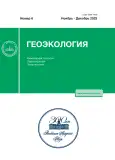FIELD AND MODEL RESEARCH OF THE GROUNDWATER FLOWS IN THE AREA OF THE PAKS-2 NPP CONSTRUCTION, HUNGARY
- Authors: Nikulenkov A.M.1,2, Novitskaya O.I.2, Rumynin V.G.1,2, Vil’kina M.V.1,2, Shvarts A.A.1,2, Sindalovskii L.N.1,2
-
Affiliations:
- St.Petersburg Division, Sergeev Institute of Environmental Geoscience, Russian Academy of Sciences
- St.Petersburg State University
- Issue: No 6 (2023)
- Pages: 47-61
- Section: MODELS IN ENGINEERING GEOLOGY AND HYDROGEOLOGY
- URL: https://journals.rcsi.science/0869-7809/article/view/233678
- DOI: https://doi.org/10.31857/S0869780923060061
- EDN: https://elibrary.ru/CTVEDE
- ID: 233678
Cite item
Full Text
Abstract
The construction of the nuclear power plant (NPP) requires conducting a large number of engineering and hydrogeological surveys, as well as assessment of the design decisions’ safety. A deep excavation pit at the Paks II NPP construction site requires execution of the cut-off wall due to extremely high groundwater saturation of the alluvial deposits. However, lithological anisotropy and the presence of dislocation zones did not allow identifying the appropriate depth for the cut-off wall construction. Unfortunately, engineering geological boreholes with a 20-meter distance between them and surface and borehole geophysical surveys could not identify the hydrogeological units. Thus, to conceptualize the hydrogeological settings, an analysis of the groundwater head distribution and the large-scale pumping tests were conducted. The interpretation of the geological data and the distinguishing of the hydrogeological units were carried out iteratively using the hydrogeological numerical model. The flow model could represent the hydraulic head distribution, the response of the lithologically heterogeneous layers to the water fluctuations in the Danube river, and the pumping tests carried out at the different depths. The results of the hydrogeological modeling revealed the aquitard to be continuous throughout the territory; however, its top’s depth changes from 30–35 to 90 m within the construction site of the Paks II NPP. This complex geometry of the aquitard is controlled by the plicated dislocation zone, which cuts the construction site in half and is revealed as the right wall of the graben.Correct hydrogeological stratification enabled us to ensure waterproof activities such as the cut-off wall construction using the hydrogeological model when excavating a deep pit for the Paks II NPP. This also minimizes the hydrodynamic impact on the closely located NPP Paks in operation.
About the authors
A. M. Nikulenkov
St.Petersburg Division, Sergeev Institute of Environmental Geoscience, Russian Academy of Sciences; St.Petersburg State University
Author for correspondence.
Email: annik@hgepro.ru
Russia, 199004, St. Petersburg, Srednii pr. 41; Russia, 199034, St. Petersburg,
Universitetskaya nab. 13
O. I. Novitskaya
St.Petersburg State University
Email: annik@hgepro.ru
Russia, 197183, St. Petersburg, Savushkina ul. 82
V. G. Rumynin
St.Petersburg Division, Sergeev Institute of Environmental Geoscience, Russian Academy of Sciences; St.Petersburg State University
Email: annik@hgepro.ru
Russia, 199004, St. Petersburg, Srednii pr. 41; Russia, 199034, St. Petersburg,
Universitetskaya nab. 13
M. V. Vil’kina
St.Petersburg Division, Sergeev Institute of Environmental Geoscience, Russian Academy of Sciences; St.Petersburg State University
Email: annik@hgepro.ru
Russia, 199004, St. Petersburg, Srednii pr. 41; Russia, 199034, St. Petersburg,
Universitetskaya nab. 13
A. A. Shvarts
St.Petersburg Division, Sergeev Institute of Environmental Geoscience, Russian Academy of Sciences; St.Petersburg State University
Email: annik@hgepro.ru
Russia, 199004, St. Petersburg, Srednii pr. 41; Russia, 199034, St. Petersburg,
Universitetskaya nab. 13
L. N. Sindalovskii
St.Petersburg Division, Sergeev Institute of Environmental Geoscience, Russian Academy of Sciences; St.Petersburg State University
Email: annik@hgepro.ru
Russia, 199004, St. Petersburg, Srednii pr. 41; Russia, 199034, St. Petersburg,
Universitetskaya nab. 13
References
- Bochever, F.M., Garmonov, I.V., Lebedev, A.V., Shestakov, V.M. [Fundamentals of hydrogeological calculations]. Moscow, Nedra Publ., 1969, 368 p. (in Russian)
- Sindalovskii, L.N. [Hydrogeological calculations using ANSDIMAT software]. St. Petersburg, Nauka Publ., 2021, 891 p. (in Russian)
- Terzagi, K., Pek, R. [Rock mechanics in engineering practice]. Moscow, Gosstroiizdat Publ., 1958, 607 p. (in Russian)
- Alabert, F. Stochastic imaging of spatial distributions using hard and soft information. Master’s thesis. Stanford University. 1987, 198 p.
- Berg, S. Comparison of hydraulic tomography with traditional methods at a highly heterogeneous site. Groundwater, 2011, vol. 53, pp. 71–89.
- Evans, D.W. Pool, D.R. Aquifer compaction and ground-water levels in South-Central Arizona. U.S. Geological Survey Water-Resources Investigations Report, 1999, P. 57.
- Haas, J. Geology of Hungary. Springer Publ., 2013, 265 p.
- Illaman, W.A. Hydraulic Tomography in Fractured Granite: Mizunami Underground Research site, Japan. Water Resources Research, 2009, vol. 45, p. 18.
- Luo, N., Zha, Y. Park, Y.J., Berg, S.J. Three-dimensional hydraulic tomography analysis of long-term municipal wellfield operations: Validation with synthetic flow and solute transport data. Journal of Hydrology, 2020, vol. 590, 15 p.
- Niswonger, R.G., Panday, S., Ibaraki, M. MODFLOW-NWT. A Newton formulation for MODFLOW-2005. U.S. Geological Survey, 2011, 56 p.
- Teloglou, I.S., Bansal, R.K. Transient solution for stream-unconfined aquifer interaction due to time varying stream head and in the presence of leakage. Journal of Hydrology, 2012, vol. 428–429, 12 p.
- Zhao, Z. Illman, W.A. Improved high-resolution characterization of hydraulic conductivity through inverse modeling of HPT profiles and steady-state hydraulic tomography: Field and synthetic studies. Journal of Hydrogeology, 2022, vol. 612, 14 p.
- Zhao, Z., Illman, W.A. Zha, Y. Yeh, T.C.J., Mok, C.M.B., Berg, S.J., Han, D. Transient hydraulic tomography analysis of fourteen pumping tests at a highly heterogeneous multiple aquifer–aquitard system. Water, 2019, vol. 11 (9), 18 p.
- Zhao, Z. Geostatistical analysis of high-resolution hydraulic conductivity estimates from the hydraulic profiling tool and integration with hydraulic tomography at a highly heterogeneous field site. Journal of Hydrogeo-logy, 2023, vol. 617, 18 p.
Supplementary files






















